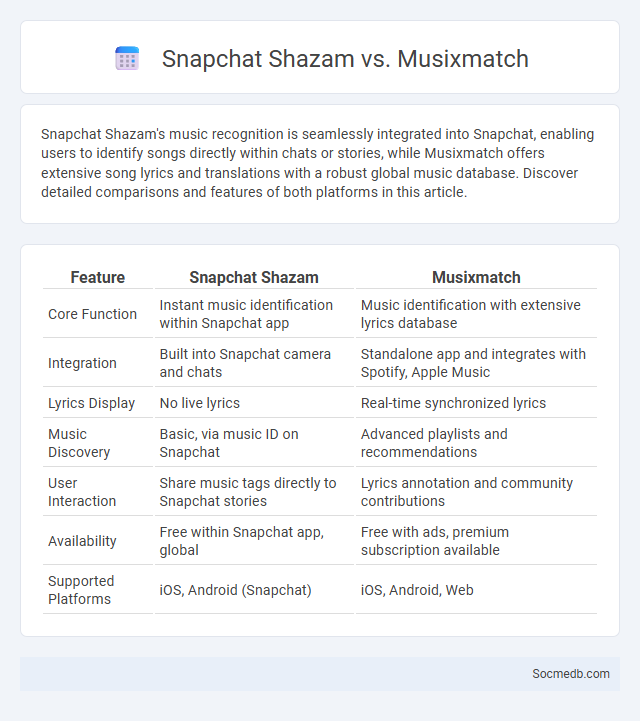
Photo illustration: Snapchat Shazam vs Musixmatch
Snapchat Shazam's music recognition is seamlessly integrated into Snapchat, enabling users to identify songs directly within chats or stories, while Musixmatch offers extensive song lyrics and translations with a robust global music database. Discover detailed comparisons and features of both platforms in this article.
Table of Comparison
| Feature | Snapchat Shazam | Musixmatch |
|---|---|---|
| Core Function | Instant music identification within Snapchat app | Music identification with extensive lyrics database |
| Integration | Built into Snapchat camera and chats | Standalone app and integrates with Spotify, Apple Music |
| Lyrics Display | No live lyrics | Real-time synchronized lyrics |
| Music Discovery | Basic, via music ID on Snapchat | Advanced playlists and recommendations |
| User Interaction | Share music tags directly to Snapchat stories | Lyrics annotation and community contributions |
| Availability | Free within Snapchat app, global | Free with ads, premium subscription available |
| Supported Platforms | iOS, Android (Snapchat) | iOS, Android, Web |
Introduction to Music Identification Apps
Music identification apps use advanced audio recognition technology to analyze sound waves and match them with vast databases of songs worldwide. These apps provide instant information about a song's title, artist, and album, enhancing user engagement on social media platforms by enabling seamless sharing and discovery. Popular examples include Shazam, SoundHound, and Musixmatch, which integrate with social media to boost music interaction and viral trends.
Overview of Snapchat Shazam Integration
Snapchat integrates Shazam to allow users to quickly identify songs playing around them by simply pressing and holding the camera screen. This seamless feature enhances your social media experience by combining music discovery with visual sharing, enabling instant access to song details without leaving the app. The integration leverages Shazam's powerful audio recognition technology, making Snapchat a multifunctional platform for entertainment and interaction.
Musixmatch Features and Capabilities
Musixmatch offers a robust platform for music lovers by providing real-time synchronized lyrics that enhance the listening experience across various streaming services. Its extensive multilingual lyrics database supports global accessibility, while features like offline lyrics and song identification using audio recognition technology boost user engagement and convenience. Integration with popular apps such as Spotify, Apple Music, and Instagram Stories enables seamless sharing and discovery, making Musixmatch a versatile tool in the social media ecosystem.
Shazam’s Standalone Functionality
Shazam's standalone functionality allows users to identify music tracks instantly without the need for linking to other apps, providing a seamless and efficient experience. This feature enhances user engagement on social media platforms by enabling real-time music discovery and sharing directly from the app. With advanced audio recognition algorithms, Shazam maintains high accuracy and speed, making it a preferred tool for music enthusiasts across social networks.
User Experience: Snapchat Shazam vs Musixmatch
Snapchat Shazam offers seamless music recognition integrated within social interactions, providing quick song identification without leaving the app, enhancing Your overall user experience. Musixmatch excels in delivering accurate synchronized lyrics and a vast music database, allowing users to deeply engage with their favorite tracks. Both platforms prioritize user engagement but cater to different needs: Snapchat Shazam for instant social sharing and Musixmatch for enriched lyrical content.
Accuracy and Recognition Performance
Social media platforms constantly enhance their accuracy and recognition performance through advanced algorithms and machine learning techniques, ensuring that content is properly categorized and targeted to relevant audiences. Your experience improves as platforms accurately identify images, speech, and text, leading to more personalized interactions and effective content moderation. Optimized recognition systems reduce errors in user tagging and content recommendations, boosting engagement and trust across social networks.
Interface and Accessibility Comparison
Social media platforms differ significantly in interface design, with Instagram emphasizing visual content through a clean, intuitive grid layout, while Twitter prioritizes text-based updates with a streamlined feed interface. Accessibility features vary widely, as Facebook incorporates robust screen reader support and customizable font sizes, whereas TikTok focuses on automated captions and voice controls to enhance user experience for individuals with disabilities. Optimizing these platforms' interfaces for both usability and accessibility directly impacts user engagement and inclusivity across diverse audiences.
Social Sharing and Community Integration
Social sharing on social media platforms enhances user engagement by enabling seamless content distribution across networks, increasing visibility and driving organic traffic. Community integration fosters active interaction through groups, forums, and collaborative features, promoting brand loyalty and deeper user connections. Leveraging social sharing tools alongside robust community frameworks maximizes user retention and amplifies content reach effectively.
Pros and Cons of Each Platform
Facebook offers extensive reach and detailed targeting for advertisers but faces challenges with privacy concerns and declining younger user engagement. Instagram excels in visual storytelling and influencer marketing, yet algorithm changes can limit organic reach for your content. Twitter is ideal for real-time updates and customer interaction but struggles with moderation issues and character limits that restrict message depth.
Conclusion: Which Music Tool Wins?
Evaluating music tools for social media reveals that platforms like TikTok and Instagram Reels dominate due to their integrated music libraries and viral potential. Spotify's collaborative playlists and music sharing features enhance user engagement but lack the immediacy of video-driven tools. TikTok's algorithm and vast sound library ultimately position it as the leading music tool for social media influence and content creation.
 socmedb.com
socmedb.com